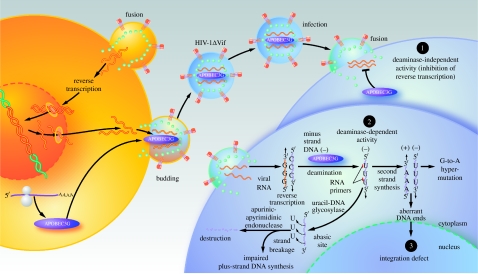Figure 1.
Sequential strategies for the restriction of HIV-1 by virion-incorporated A3G. In the absence of Vif, A3G in the cytoplasm of virus-producing cells is effectively incorporated into budding virions and carried forward into the next target cells, where it can act as a potent inhibitor of HIV-1 replication. These inhibitory effects involve both deaminase-independent and -dependent antiviral actions. A3G bound to HIV-1 RNA may physically impede reverse transcriptase movement on the viral RNA template, resulting in a deaminase-independent block in reverse transcription (1). However, this inhibition is frequently incomplete, and minus-strand viral DNA is generated. A3G mediates extensive deamination of dC residues in this newly synthesized single-stranded viral DNA. This action of A3G effectively halts HIV replication because of the resulting dG-to-dA changes in the viral plus strand or because the uracil-containing minus strand is destroyed by the actions of uracil DNA glycosylase and apurinic–apyrimidinic endonuclease (2). Additionally, diminished chromosomal integration of the double-stranded viral DNA may occur due to defects in tRNALys3 primer cleavage, leading to the formation of viral DNA with aberrant ends (3).

